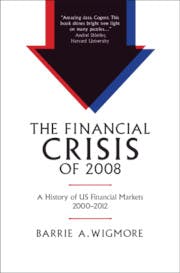
Book Review
The Financial Crisis of 2008: A History of US Financial Markets, 2000-2012, 2021
By Barrie A. Wigmore
The memory of financial market participants is usually very short. Investors are generally more sensitive to their current portfolio return than they are about their long-term performance. The irony of this is that long-term performance really determines an investor’s overall financial health, success, and happiness. This intense focus on the short-term view is why books about past financial crises are so important – they remind us of the extreme financial challenges that have occurred, what caused them, and how they were managed. Barrie Wigmore’s analysis of the 2008 financial crisis is an excellent case in point.
The author presents his case that the 2008 financial crisis was caused not solely by the housing bubble and sub-prime lending as is commonly accepted, but rather by multiple exaggerated financial developments. The additional developments highlighted include unusual capital flows associated with a housing price bubble, increased consumer borrowing, highly leveraged corporate debt, and the commercial real estate market. To support his argument, Wigmore analyzes the role of sophisticated institutions that participated in the development of the 2008 financial crisis. These include State and local retirement funds, Fannie Mae and Freddie Mac, the commercial banks, insurance companies, endowments, and European banks.
Wigmore successfully argues the case that this group of sophisticated investors stretched the risk-return tradeoff they were willing to take, after the dot-com crash of the early 2000s minimized their conventional investment returns. The institutions, led by equally sophisticated individuals (whose focus was on the short term), required excessive returns on their investments to maintain their solvency (pension funds), or spending habits (foundations and university endowments), or competitive pricing of their products (insurance companies and banks). Adopting increased leverage is a common denominator among the actions of each of these apparently sophisticated institutions. With increased leverage comes increased risk.
The author tells the story and supports his argument adeptly using a large number of charts and analytical data tables. The entire gamut of investment product is considered, from high yield debt and hedge funds to derivatives and private equity. There is a vast wealth of data and charts to study in this book. Wigmore is to be commended, and thanked, for compiling this data succinctly in his book. The content of the book is principally about presenting the timeline of events through this large number of data tables and charts. To make it more manageable to absorb this data, the timeline is broken down into several periods – pre-2006, 2006-2007, and the crash of 2008.
The deficiency of this argument is that it lacks any behavioural analysis and insight relating to the crisis. There are a few minor forays into some of the personalities of the industry, such as when he briefly describes the role of Robert Rubin, a former Treasury Secretary and Chairman of Citigroup during the crisis (264-265). However, there is little analysis or discussion, for example, about the role of executive compensation policies related to taking on increasing risk and leverage at the organization level. Including this insight would make the book more interesting and relevant for the average reader. Wading through dry data and charts is not as appealing to most readers as reading the story of leadership and management decision-making.
Presenting the argument through a vast number of charts and data tables makes the argument one based on hindsight. For authors such as Wigmore, relying on hindsight using a summation of past data can be a relatively easy process. What may be more relevant and challenging, especially with today’s interesting markets, is how to improve foresight to avoid financial crisis. This is where behavioural economics is taking on an increasing important role. It is only recently that the economics profession has recognized this area of study through the work of Richard Thaler or Robert Schiller. The book also lacks any investigation into the role of the supposedly ‘independent’ ratings agencies in the 2008 financial crisis. There is no shortage of evidence that their failings materially contributed to the market crash.
The Financial Crisis of 2008 makes a good companion to other works that have studied the market crash and have included these absent areas of investigation and analysis. Useful comparisons can be made with Roger Lowenstein (The End of Wall Street (2010)), Howard Davies (The Financial Crisis: Who is To Blame (2010)), and indeed, the U.S. government’s own Financial Crisis Inquiry Report (2011).
To his great credit, Wigmore provides the reliable data needed for a thorough and factual analysis of this significant historical financial event. Although The Financial Crisis of 2008 only covers a mere 12-year period, it is a great reference source for those looking for an explanation for a short-term crisis in the long history of financial markets.
Mark S. Bonham
University of Toronto